University of Texas at San Antonio
| The University of Texas at San Antonio | |
|---|---|
 |
|
| Motto | Disciplina Praesidium Civitatis (A Cultivated mind is the guardian genius of democracy) |
| Established | June 5, 1969 |
| Type | Public university |
| Endowment | U.S. $54.08 million[1] |
| President | Ricardo Romo, Ph.D. |
| Academic staff | 1,307 [2009 Fall][2] |
| Admin. staff | 3,210 [2009 Fall][3] |
| Students | 28,955 [2009 Fall][4] |
| Undergraduates | 25,006 [2009 Fall][5] |
| Postgraduates | 3,949 |
| Location | San Antonio, Texas, USA |
| Campus | Main Campus: Urban, 600 acres |
| Colors | Orange and Blue |
| Nickname | Roadrunners |
| Mascot | Rowdy |
| Website | www.utsa.edu |

The University of Texas at San Antonio (also referred to as UTSA) is a state university located in San Antonio, Texas, United States. With an enrollment of over 29,000 students[6], it is the second-largest of nine separate components in the University of Texas System, the seventh-largest in Texas[7], and the largest public university in Texas outside of the six flagship universities from the various systems.
The university serves the San Antonio metropolitan area and the South Texas region through three campuses: Main Campus, Downtown Campus in Downtown San Antonio, and Hemisfair Park Campus. The main campus is situated on 600 acres (2.4 km²), at the intersection of Interstate 10 and Loop 1604 near the northern edge of San Antonio, Texas in Bexar County.
The University of Texas at San Antonio offers 132 undergraduate and graduate programs in different fields including 64 bachelor's, 47 master's, and 21 doctoral degree programs.[7]
Contents |
History
The University of Texas at San Antonio was founded on June 5, 1969 by Governor Preston Smith.[8] In 1970, The University of Texas Board of Regents appointed the university's first president, Arleigh B. Templeton, who served from 1970–1972, and received a land donation of 600 acres (2.4 km2) in northwest San Antonio for the site of UTSA.[9] Architects Ford, Powell and Carson Inc. were assigned to design a master plan for the university.[10] Although the university was established in 1970, students temporarily attended class at the Koger Center, where the administrative offices were held, until 1975 when construction on the northwest San Antonio campus was completed.[7][9] UTSA began with five colleges: Business, Fine and Applied Arts, Humanities and Social Sciences, Multidisciplinary Studies and Science and Mathematics.[10]
Academics
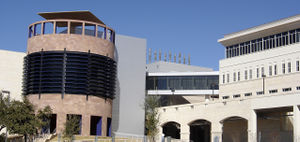
UTSA currently has eight colleges including:
- Business
- Education and Human Development
- Engineering
- Honors College
- Liberal and Fine Arts
- Public Policy
- Architecture
- Sciences
All programs are fully accredited by the Southern Association of Colleges and Schools, and the UTSA College of Business is accredited by the Association to Advance Collegiate Schools of Business.
Research initiatives
In addition to the educational advantages UTSA offers, the school had a $1.2 billion economic impact on San Antonio in 2008. As of 2008 the school directly employs 5,628 people.[11]
In a 2007 study released by Academic Analytics, UTSA was ranked fifth for faculty scholarly productivity among other large research universities in the state of Texas.[12]
Proposition 4 was passed by Texas voters in November 2009. This piece of legislation named 7 emerging research universities in Texas that could compete for additional state funds in an effort to increase the number of tier 1 institutions in Texas. Factors such as research expenditure, graduate degrees awarded, and scholarly productivity all play a part in which schools receive the most funding.[13]
The school reached a new record of $46.5 million for research expenditures in 2009. This represents a five-year increase of 97%. It was the largest growth among the 7 emerging institutions.[14]
Athletics
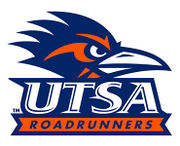
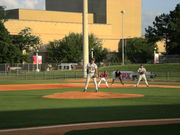
UTSA is San Antonio's only NCAA Division I institution with 16 intercollegiate sports including basketball, cross country, golf, indoor track & field, men's baseball, outdoor track and field, tennis, fencing, women's soccer, women’s softball, and women's volleyball. UTSA's rival in most sports is Texas State.
The sport that attracts the most student attention is men's basketball. The UTSA team plays at the Convocation Center and is a member of the Southland Conference.
UTSA is one of the largest universities in the United States without a football team. In September 2007, students passed a referendum to increase funding for the athletic department by doubling the athletics fee over a five-year period. The additional funding allows renovations of existing athletics facilities, increased institutional support of existing intercollegiate sports programs, and an expansion of the athletics program with the addition of a Division I FCS football team, playing at the Alamodome, by 2011. The plan was approved by the University of Texas System board of regents in December 2008.[15]
In 2007 UTSA added ice hockey to their Club Sports, which is part of the recreation center. The UTSA Roadrunners Hockey Team plays at the Northwoods Ice & Golf Centre which is located at US 281 & Loop 1604 on the North side of San Antonio.
Spirit and tradition
Alma mater
Lyrics by Alan Craven, former dean and professor of COLFA. Music by Clarence ("Joe") Stuessy, retired professor and former chair of Department of Music.
"Hail UTSA"
- From our hills of oak and cedar
- To the Alamo,
- Voices raised will echo
- As, in song, our praises flow.
- Hail Alma Mater!
- Through the years our loyalty will grow.
- The University of Texas
- San Antonio.[16]
School colors and mascot
The official colors of The University of Texas System are orange and white and, according to Board of Regents Rules and Regulations, "an institution may adopt one additional color to be used in connection with athletic and other activities of the institution."[17] Upon recommendation from the UTSA Student Representative Assembly, the Board of Regents approved the addition of navy to the orange and white for UTSA's school colors.
The roadrunner, a bird representative of the Texas Hill Country and the Southwest, was voted the UTSA mascot in 1977[18]. "Rowdy the Roadrunner" attends many university functions and games.
On March 1, 2008, UTSA Athletics unveiled its new logos during the Homecoming Game against Texas A&M University–Corpus Christi. The athletic markings were changed due to noticeable similarities to the University of Kansas Jayhawk.[19]
Best Fest and Fiesta UTSA
Fiesta UTSA, an annual event held in April, began in 1978.[20] The first Fiesta UTSA was attended by over 1,000 students and included music, a jalapeño eating contest, a watermelon spitting contest, a dunk tank, and other activities.[21] Fiesta UTSA features dozens of booths set up under the Sombrilla in a carnival atmosphere. The booths are run by Registered Student Organizations and offer food, drinks and games. The Campus Activities Board sponsors bands and other musicians throughout the day. Fiesta UTSA became the kickoff event for Fiesta San Antonio each spring, having been added to the official Fiesta San Antonio schedule in 1980.[22] The Fiesta royalty are present at the ribbon-cutting ceremony that marks the official beginning of Fiesta.
Best Fest, an annual celebration held in October, began in 1978 (as "Bestfest") as "a special salute to five of the state's outstanding festivals," including New Braunfels's Wurstfest, Corpus Christi's Buccaneer Days, San Antonio's Fiesta, the Texas State Fair in Dallas, and George Washington's Birthday Celebration in Laredo.[20] It was presented by the student organization Variety 79.[20] In 1979, the event was said to be "a salute to five of the city's outstanding festivals: Fiesta Navidena, King William Fair, La Feria del Rio, the San Antonio Stock Show and Rodeo, and the Texas Folklife Festival."[20] In the late 1970s, Best Fest included performances by the UTSA Brass Ensemble and UTSA Jazz Ensemble, several contests such as the jalapeño eating contest, egg toss, "Walking the Plank Contest," "Pee Wee Bicycle Races," and others. The modern Best Fest incorporates a Halloween theme with costume and booth-decorating contests.
Housing
UTSA offers four selections for on-campus housing:
- Chaparral Village: Newly built apartment-like complex with 2- or 4-bedroom configurations, housing 1,000 students. Amenities include paid utilities and broadband internet access. Four "Neighborhood Centers" provide laundry and dishwashing appliances, pool/ping pong tables, and large widescreen televisions.
- Chisholm Hall: The oldest housing facility on campus, a 4-story building with traditional dorm-style housing for 500 residents. It offers some of the largest residence hall rooms in a Texas public university, with rooms in 1- and 2-person configurations.
- University Oaks: Apartments with 1-, 2- and 4-bedroom configurations, second oldest housing complex on campus.
- Laurel Village: Similar in design to Chaparral Village, UTSA's newest housing complex completed construction in 2008.
More than 8,000 students live off-campus within walking distance of campus. These student housing complexes include: Alpin Park, Aspen Heights, Avalon Place, Broadstone Ranch, Campus Side, Chase Hill, The Grove, High View Place, Highlands, Hill Country Place, Las Colinas, Madera, Maverick Creek, The Outpost, and The Reserve.
Additional campuses
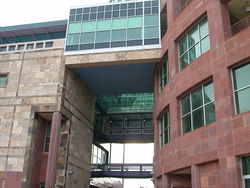
UTSA also features an 11 acre (45,000 m²) campus located in downtown San Antonio. Called the UTSA Downtown Campus, it houses the College of Public Policy and the College of Architecture. The UTSA HemisFair Park Campus stands as the third branch of UTSA, holding the Institute of Texan Cultures museum.
Expansion and growth
From 2006 to 2009 the school completed over $250 million in construction projects.
UTSA has also purchased 125 acres (0.51 km2) of land near the Main Campus in 2007. This land was named Park West in 2009 and became part of the school's Main Campus. The school has plans for more than $150 million in new athletic facilities at Park West.
The school underwent an extensive remodel in 2009 of older buildings including the JPL, HSS, and MS buildings. Two new multi-function office buildings broke ground in 2009.
Both the softball and baseball fields at the UTSA Main Campus will undergo renovations in early 2010. Plans include new seating, dugouts, fencing, concession, picnic areas, and press boxes. UTSA plans to construct new baseball and softball stadiums at Park West by 2014. The existing facilities will become intramural fields.
A new ceramics studio broke ground in 2009 at the Main Campus. In addition several labs at West Campus began an extensive remodel.
Dining services at UTSA also expanded in 2008-2009. New additions include Starbucks, Panda Express, Taco Cabana, Burger King, and Chili's Too. Other new services on-campus include a hair salon, technology store, UPS store and DVD rental kiosk. A campus radio station also plans to debut in 2010.
 Engineering Building |
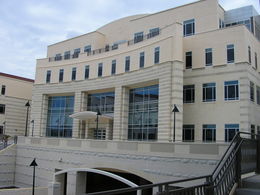 Main Building |
 Biotechnology Sciences and Engineering Building |
Sombrilla Plaza |
Student activities
At the heart of student life are 180 student organizations that represent a diverse array of interests: cultural, honorary, military, political, professional, religious, service, social Greek, special interest, and sports and recreation.
Among the most active groups are the sponsored organizations that receive funding from the University Student Services fee:
- Campus Activities Board (CAB)
- Greek Life:
- 5 National Panhellenic Conference chapters: Alpha Omicron Pi, Alpha Sigma Alpha, Gamma Phi Beta, Phi Mu, and Sigma Kappa. On January 2010, Zeta Tau Alpha will become the 6th installed chapter at the university.
- 5 North-American Interfraternity Conference chapters: Sigma Phi Epsilon, Lambda Chi Alpha, Kappa Sigma, Sigma Pi, and Tau Kappa Epsilon. Pi Kappa Phi began colonization Fall of 2009.
- 6 National Pan-Hellenic Council chapters: Alpha Kappa Alpha, Alpha Phi Alpha, Delta Sigma Theta, Kappa Alpha Psi, Phi Beta Sigma, and Omega Psi Phi.
- 6 National Multicultural Greek Council chapters: Epsilon Sigma Alpha, Kappa Delta Chi, Phi Iota Alpha, Sigma Iota Alpha, Sigma Lambda Alpha, and Sigma Lambda Beta. Additionally, Delta Xi Nu and Iota Nu Delta began colonization in the Fall of 2009.
- Student Government Association (SGA)
- Volunteer Organization Involving Community Education and Service (VOICES)
The Paisano
UTSA also hosts a nationally recognized weekly newspaper, The Paisano. It has remained fully independent of the administration since its inception in 1981. The newspaper is published weekly every Tuesday.
The Independent
UTSA's second student-run news organization was founded in September 2006. The Independent [23] is an online newspaper experimenting with newer forms of media, such as podcasting. In Spring 2008, The Independent launched a monthly print issue. New online editions are published every Monday, print issues are published monthly. As of January 20, 2010, it appears The Independent is now defunct as the last issue was on April 29, 2009.
The College of Engineering Student Council
The College Of Engineering Student Council is the student voice of The University of Texas at San Antonio College of Engineering. They are designed to serve and promote interaction among students and the engineering community. Their mission is to cultivate an active student body to encourage pride and tradition and to serve as the collective voice for all UTSA Engineering students. Their Vision is to serve as the cornerstone organization within engineering RSO's as acknowledged by their integration within the college of engineering and UTSA. They offer opportunities in STEM outreach, host guest speakers, and compete in independent engineering competitions. Any student at UTSA's College of Engineering is considered a member and has a voice, but voting privileges is limited to 2 representatives from any engineering organization.
Campus life
With the addition of more on-campus housing in recent years, campus life has evolved to become much more active. Before basketball games, tail-gate parties and body painting in the school's colors are common. There are many traditions as well, including Best Fest and Fiesta UTSA, both are events for students organizations to raise funds while providing entertainment and food to the student body.
A small percentage of incoming freshmen are in the CAP program, an agreement which allows students who are not initially accepted into UT - Austin to choose to come to UTSA. If they maintain a certain GPA and restrict themselves to taking specific classes, they will be granted admission to UT. The program is also in effect at other UT system schools, including UT–Arlington, and continues to draw more and more students every year. The CAP program has become more controversial as more freshmen are enrolled. UTSA officials have stated that only about 30% of those in the CAP program end up at UT - Austin the following school year. Despite this, however, many students are opting to stay at UTSA, as the university has been recognized for its growing research and business programs.
Notable people
References
- ↑ "UTSA Quick Facts 2008" (PDF). 2009-09-30. http://www.utsa.edu/ir/quickfacts/Fast%20Facts%20Final%20updated%20Fall%202008.pdf. Retrieved 2009-09-30.
- ↑ http://www.utsystem.edu/news/files/FastFacts2010.pdf
- ↑ http://www.utsystem.edu/news/files/FastFacts2010.pdf
- ↑ http://www.utsa.edu/infoguide/ch1.html
- ↑ http://colleges.usnews.rankingsandreviews.com/best-colleges/san-antonio-tx/utsa-10115/@@Index_SB.html
- ↑ http://sanantonio.bizjournals.com/sanantonio/stories/2009/09/14/daily25.html
- ↑ 7.0 7.1 7.2 UTSA Overview - University of Texas at San Antonio
- ↑ "UTSA Uncovered: History". http://www.utsa.edu/visitor/utsa_uncovered/utsahistory.cfm. Retrieved 2008-05-28.
- ↑ 9.0 9.1 "University of Texas San Antonio". Handbook of Texas Online. http://www.tshaonline.org/handbook/online/articles/UU/kcu13.html. Retrieved 2008-05-28.
- ↑ 10.0 10.1 "UTSA.edu - UTSA History". http://www.utsa.edu/About/History/. Retrieved 2008-05-28.
- ↑ http://www.utsa.edu/impact/docs/ImpactTrifold.pdf
- ↑ UTSA ranks fifth in Texas research productivity, "UTSA Today", June 20, 2007.
- ↑ http://www.thecb.state.tx.us/reports/PDF/1899.PDF?CFID=5685577&CFTOKEN=72777635
- ↑ http://www.texasnonprofits.org/Article/?ArticleID=11076
- ↑ McBride Lewis, Marianne (December 18, 2008). "UTSA gets green light". utsa.edu (UTSA Today). http://www.utsa.edu/today/2008/12/football.cfm. Retrieved 2008-12-18.
- ↑ "UTSA Undergraduate Catalog 2008-2010". http://www.utsa.edu/ucat/. Retrieved 2009-04-18.
- ↑ http://www.utsystem.edu/bor/rules/RRRas1.pdf Rules and Regulations of the Board of Regents
- ↑ http://www.lib.utexas.edu/taro/utsa/00177/utsa-00177.html Inventory of the University Communications Records, 1973-2008
- ↑ UTSA Athletics unveils new logos, word marks > UTSA Today > University of Texas at San Antonio
- ↑ 20.0 20.1 20.2 20.3 http://www.lib.utexas.edu/taro/utsa/00150/utsa-00150.html Press release of April 1978, University Communications Records, UA 16.01, Archives and Special Collections, UTSA Library
- ↑ "The First Fiesta UTSA". UTSA Library, Archives and Special Collections Department. http://libtmp.lib.utsa.edu/blogs/index.php/2009/04/17/the-first-fiesta-utsa-1978?blog=7. Retrieved 2009-04-18.
- ↑ http://www.lib.utexas.edu/taro/utsa/00177/utsa-00177.html "It's Official." UTSA Bulletin vol. 8, no. 2 (February 1980). University Publications Collection: University Serials and Journals Collection, UA 1.02.01, Archives and Special Collections, UTSA Library
- ↑ [1], The Independent
External links
- The University of Texas at San Antonio
- UTSA Master Plan
- UTSA Athletics
- Google Maps satellite view of UTSA
|
||||||||||||||||||||||
|
||||||||
|
|||||||||||||||||||||||||||||
|
|||||||||||||||||||||||
|
|||||||||||||||||||||||